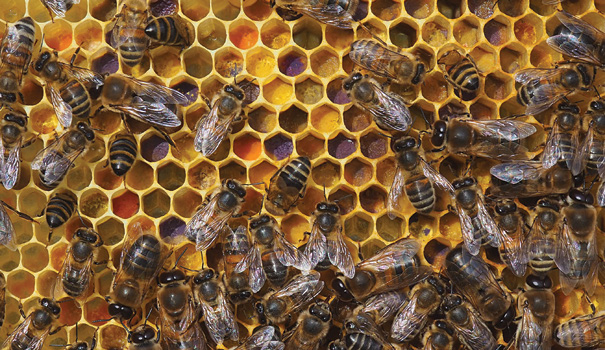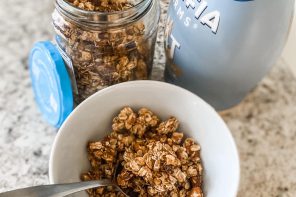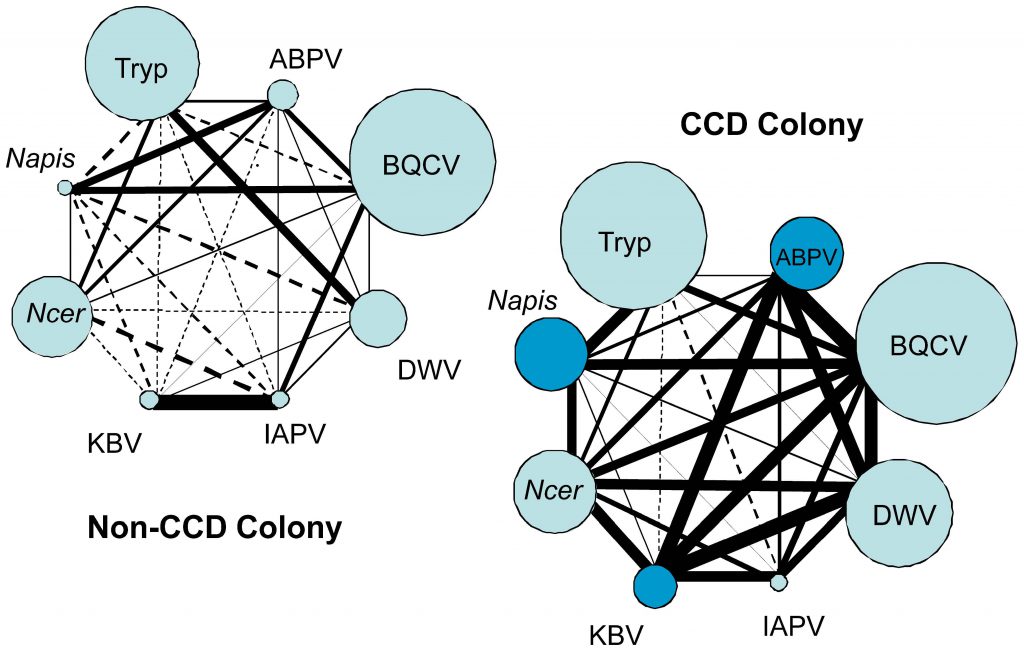By: Celia Davi NBD
Apis mellifera lives in large communities with many little bodies confined in a nest (or hive) in an atmosphere which is both warm and fairly humid – ideal conditions for the multiplication and spread of pathogens. Notwithstanding varroa mites, how do most colonies manage to stay reasonably healthy most of the time? Keeping bees in hives is an artificial situation and can upset the balance that exists between bees, environment and pathogens. By what methods does the colony as a whole unit, and the individual bee, stay healthy? What factors can impact on this?
Colony-level immunity
Honey bees are very efficient at maintaining the colony in a fit condition providing certain requirements are met. Several factors are involved.
Cleanliness is very important in controlling the spread of pathogens, and honey bees are particularly clean animals. Everything in the hive is swabbed down with a salivary solution which contains small quantities of hydrogen peroxide, produced as a breakdown product of glucose, using the enzyme glucose oxidase. This is a mild disinfectant and bees pay particular attention to the cells where the queen is going to lay. Worker bees can use their tongues almost like mops in this process.
Breeding rates of bees can be very rapid, particularly in the early part of the season and a colony can often outbreed an infection such as nosema. At the same time that new bees are being produced, many are dying and, as a result, many pathogens are removed.
Thermoregulation can control some pathogens, particularly chalkbrood fungus (Ascosphaera apis) which needs a temperature of about 30oC for its spores to germinate. As the hive temperature is normally maintained at about 5oC above this, the fungus is unable to take over. Small or unbalanced colonies, particularly nuclei, are at risk as they are not always able to maintain a constant temperature.
Removal of infection from the colony is achieved in several ways. Most foragers die in the field and there appears to be an altruistic effect so that sick bees may leave the colony. Any bees that die in the hive are removed by other worker bees. Changes in behaviour can also help: the sacbrood virus is carried in the hypopharyngeal (brood food) glands of adult bees and overwinters there. They exhibit no symptoms, but their development is accelerated so that they transition to foraging at a much younger age than normal and rarely collect pollen when they are foraging. Fewer bees can therefore pass the virus on to the larvae.
Barrier methods serve to keep some individuals separated from others. The obvious case example is the larvae, each of which is reared in an individual cell. There is normally some separation of adults: nurse bees and queen in the central part of the brood nest, older receiver bees and Foragers bringing in nectar do not enter the brood nest and those bringing in pollen drop it in cells adjacent to and near the brood. However, this pollen is processed by mixing gut contents with it, so rendering it safe by the time the nurse bees consume it and feed it to the larvae. Obviously, this is not a complete separation of bees in the nest but there is a gradual move from the centre outwards as a bee ages. Food coming in from outside, which may be contaminated with pathogens, tends to be kept away from brood and queen.

Each larva is kept separate from other larvae, so minimising spread of pathogens

Propolis is a valuable aid to combatting many micro-organisms

An intruder – a snail – being encased

Many bodies crammed together give ideal conditions for the spread of pathogens

The varroa mite affects the immunocompetence of bees in several ways
Hygienic behaviour in its simplest form involves grooming of nest mates by the bees. This can remove some ectoparasites. The true meaning of hygienic behaviours is applied to those bees that can detect dead or diseased larvae and pupae and remove them. This is not a simple process and is dependent on the sense of smell, which is better developed in some bees. Oleic acid, the ‘death pheromone’ given off by dead larvae/pupae, is undoubtedly a key trigger for hygienic behaviour, but it is not the only one.
Antimicrobial substances are produced by the microbiome, bacteria and fungi which live in the bee’s gut. These substances are added to bee bread (preserved pollen) and brood food and helps to protect the larvae.
Propolis is a substance which bees love and beekeepers hate. It is gathered by the bees from plants, which produce it to protect themselves from attack by micro-organisms. Because it comes from various plants its composition varies, but it consists of a number of resins and balsams together with essential and aromatic oils. A wild colony living in a tree will coat all the internal walls of its nest and around its entrance with propolis so that it forms an envelope and confers considerable protection. There is work being done, experimenting with using roughened wood on the insides of hive boxes, to induce the production of this envelope. Another use is to coat foreign objects which gain access to the hive and might decay, thereby causing problems. Mummified remains of mice and snails are sometimes found. In areas where the small hive beetle (Aethina tumida) is found the bees may imprison the beetles in a ‘cage’ made from propolis.
Individual immunity
One of the simplest ways to combat pathogens is to prevent them from gaining access to the body. The commonest ways in are through the body wall and from the gut.
The cuticle is the first line of defence. It is impermeable to water and is quite tough, providing that it is undamaged. The protection becomes compromised where there is damage to the cuticle from broken hairs or due to the damage caused by the varroa mite. The spiracles also provide openings. Mostly they have valves, which protect the openings, but the spiracle on the second thoracic segment (mesothorax) has no such protection and here we see that Acarapis woodii, the parasite that causes of acarine, can get into the breathing tubes (trachaea) causing disease.
The gut is an obvious means of entry and has several defence mechanisms. The proventriculus, the one-way valve which connects the crop and the ventriculus, is able to filter out many small spores and micro-organisms along with pollen grains. These are then passed into the ventriculus as a food bolus. This part of the gut is not a welcoming environment as it is acidic and contains digestive enzymes. It is lined with a single layer of cells, called an epithelium, which limits the passage of substances and micro-organisms through it into the surrounding haemolymph. This epithelium is the structure targeted by nosema, which damages it and makes it vulnerable to the passage of some viruses as well as affecting the production of enzymes and limiting the bee’s ability to digest pollen. Finally, the peritrophic membrane, which is secreted continuously along the whole length of the ventriculus and surrounds the food bolus, acts as a barrier to prevent some pathogens from passing through into the haemolymph. Unfortunately it takes a short time to develop in both the larva and the adult bee and this leaves a newly emerged larva vulnerable to attack by organisms such as Paenibacillus larvae, the bacterium causing American foulbrood.
The haemolymph circulates round the bee’s body and bathes all the internal organs. It is the site of a number of immune responses and these are triggered by the structural patterns on the outside of pathogens. These are recognised by proteins in the haemolymph and the binding of the two together triggers the various responses:
Plugging a wound by some of the haemocytes (blood cells), which migrate to the wound. Melanin is then produced to form a permanent repair. This is rather like a scab in us.
Phagocytosis effected by other haemocytes called granulocytes. These surround the invader, and the nodule which is formed by plasmatocytes is later melanised.
Production of phenoloxidase. This is an enzyme, which is essential in the formation of melanin and is produced in haemocytes which are circulating freely but is present in the inactive form of prophenoloxidase. Once an injury or invading pathogen triggers a response, a cascade begins to convert it to phenoloxidase.
All of these responses are not constant during the life of a bee. Granulocytes peak in eight-day old larvae but decrease in young adults up to about five days when they dropped still further. Plasmatocytes have not been observed in larvae and are most abundant in young adults. These also decline in older adults. Queens appear to retain these cells. Phenoloxidase, apparently, may increase with age.
Finally, and taking slightly longer, antimicrobial peptides are produced by the fat bodies in response to chemicals produced by the haemolymph. These are able to inactivate the pathogens and persist after the invaders have been defeated. There are several of these and they are not specific to a particular pathogen. They can be passed between bees and added to royal jelly.
Vitellogenin is a precursor of some yolk proteins and, although it has many other roles in the honey bee, this original function has been retained. If a queen has micro-organisms in her body, particles of these become attached to the vitellogenin molecule which will be incorporated into the yolk. This can induce an immune response in the larvae hatching from these eggs.
Finally, iRNA (interference ribonucleic acid) is the major method used to prevent viruses multiplying. This interrupts the mRNA (messenger RNA) which conveys the blueprint for more viruses from the virus to the nucleus of the cell it has attacked.
Problems which may arise
Clearly, although immune responses can be overwhelmed, the bee has quite sophisticated methods for dealing with pathogens. However, some external factors can have a big impact and all kinds of stress can give the pathogens the upper hand.
Nutrition and most importantly provision of pollen from mixed sources, is fundamental. Protein is a major constituent of pollen and is needed for the production of enzymes and antimicrobial peptides among other things. Pollen is also the source of lipids but the role of these in immunity is not well understood.
Varroa feeds on the bee’s fat bodies, thereby affecting their function, and inhibits some of the genes controlling immunity. Even very good feeding after emergence cannot replace protein lost during pupal life.
Chemicals used in agriculture, particularly some of the neonicotinoids, have been shown to lower the immunocompetence of honey bees. Neonicotinoid pesticides have been removed from general use in the UK, but it will be some time before they disappear completely from the environment and we are not clear on the effects of other chemicals.
To sum up, immunity in honey bees is a complex of interconnected processes combining both colony level protection as well as the innate system of the individual bee. Various and combined stresses, particularly resulting from nutrition and from varroa, can have adverse effects leading to even more problems. We should aim to reduce the stress on our bees as far as possible.
Celia F Davis NDB lives in Warwickshire and has had a lifelong interest in insects and gardening. She taught pure and applied biology and has written two acclaimed BeeCraft books: The Honey Bee Inside Out and The Honey Bee Around and About.
References
Simone-Finstrom, Michael et al (2017). Propolis counteracts some threats to honey bee health. Insects 8(2), 46
Gloria De Grandi-Hoffman, Gloria & Chen, Yanping (2015). Nutrition, immunity and viral infections in honey bees. Current Opinion in Insect Science Vol 10, 170–176
Richardson, Rodney T et al (2018). Morphological and functional characterisation of honey bee (Apis mellifera) haemocyte cell communities. Apidologie 49, 397-410
Hystad, Eva Marit et al (2017). Hemocyte-mediated phagocytosis differs between honey bee (Apis mellifera) worker castes. PloS One.
https://doi.org/10.1371/journal.pone.0184108
Brutscher M and Flenniken, Michelle L (2015). RNAi and antiviral defense in the honey bee. Journal of Immunology Research, Volume 2015, Article ID 941897
McFee, Alison et al (2018). A death pheromone, oleic acid, triggers hygienic behaviour in honey bees (Apis mellifera L.). Scientific Reports 8, Article number 5719
Di Pasquale, Garance et al (2013). Influence of pollen nutrition on honey bee health: do pollen quality and diversity matter? PLoS ONE 8(8): e72016.
https://doi.org/10.1371/journal.pone.0072016
Brandt, Annely et al (2016). The neonicotenoids thiacloprid, imidacloprid and clothianidin affect the immunocompetence of honey bees (Apis mellifera L.) Journal of Insect Physiology, Volume 86, March 2016 40–4







